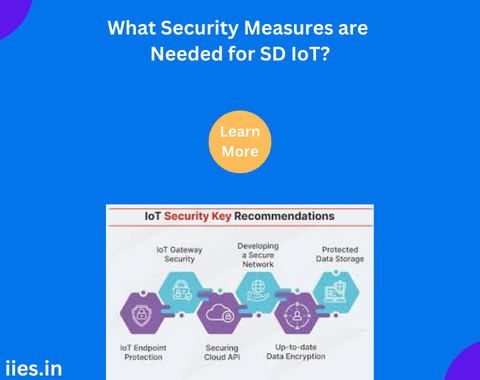
With the proliferation of IoT devices, Software-Defined IoT (SD IoT) has emerged as a prominent paradigm, promising greater flexibility, scalability, and efficiency. However, alongside its promises, SD IoT brings a myriad of security challenges, necessitating robust measures to safeguard against potential threats. In this article, we delve into the essential security measures required to fortify SD IoT deployments.
1. Authentication and Access Control:
Authentication mechanisms such as username/password combinations, biometrics, or cryptographic keys play a crucial role in verifying the identity of users and devices within SD IoT networks. Implementing strong authentication protocols ensures that only authorized entities can access sensitive data or control critical functions, mitigating the risk of unauthorized access and malicious attacks.
2. Encryption:
End-to-end encryption is paramount in securing data transmission and storage within SD IoT ecosystems. Employing robust encryption algorithms ensures that data remains unintelligible to unauthorized parties, even if intercepted. Additionally, encrypting data at rest provides an extra layer of protection against data breaches and unauthorized access to stored information.
3. Secure Device Lifecycle Management:
Effective management of the entire lifecycle of IoT devices is essential for maintaining security. This includes secure provisioning, firmware updates, patch management, and decommissioning protocols. By regularly updating firmware and applying security patches, vulnerabilities can be addressed promptly, reducing the risk of exploitation by malicious actors.
4. Network Segmentation and Isolation:
Segmenting SD IoT networks into distinct zones based on device type, function, or user access privileges helps contain potential security breaches and limit the impact of successful attacks. Implementing firewalls, VLANs, and access control lists (ACLs) enables granular control over network traffic, preventing lateral movement by attackers and minimizing the attack surface.
5. Intrusion Detection and Prevention Systems (IDPS):
Deploying IDPS solutions helps detect and mitigate suspicious activities and potential threats in real-time. By monitoring network traffic and device behavior, IDPS can identify anomalies indicative of unauthorized access attempts, malware infections, or other security incidents. Coupled with automated response mechanisms, IDPS enhances the overall security posture of SD IoT deployments.
6. Secure Communication Protocols:
Selecting secure communication protocols such as Transport Layer Security (TLS), Datagram Transport Layer Security (DTLS), or Message Queuing Telemetry Transport (MQTT) ensures the integrity and confidentiality of data exchanged between IoT devices and backend systems. By encrypting communication channels and authenticating endpoints, these protocols mitigate the risk of eavesdropping and Man-in-the-Middle (MitM) attacks.
7. Physical Security Measures:
Securing physical access to IoT devices and infrastructure is often overlooked but is equally crucial in preventing unauthorized tampering or theft. Implementing measures such as tamper-evident seals, physical locks, and surveillance systems helps safeguard against physical attacks and unauthorized access to sensitive equipment or data.
8. Continuous Monitoring and Incident Response:
Establishing robust monitoring mechanisms enables proactive threat detection and rapid incident response. Real-time monitoring of device activity, network traffic, and system logs allows security teams to identify and respond to security incidents promptly. Additionally, developing comprehensive incident response plans and conducting regular drills ensures a coordinated and effective response to security breaches or emergencies.
9. Compliance and Regulatory Considerations:
Adhering to relevant industry standards, regulations, and privacy requirements is imperative for ensuring the security and legal compliance of SD IoT deployments. Understanding and implementing frameworks such as the General Data Protection Regulation (GDPR), the Health Insurance Portability and Accountability Act (HIPAA), or the Payment Card Industry Data Security Standard (PCI DSS) helps mitigate regulatory risks and fosters trust among stakeholders.
10. Security by Design:
Integrating security principles into the design and development process of SD IoT solutions is fundamental for building resilient and secure systems from the ground up. Adopting a security-first approach involves conducting thorough risk assessments, implementing secure coding practices, and integrating security controls throughout the entire SD IoT lifecycle, thereby minimizing vulnerabilities and enhancing overall security posture.
11. Threat Intelligence Integration:
Incorporating threat intelligence feeds and services into SD IoT deployments enhances situational awareness and enables proactive defense against emerging threats. By leveraging threat intelligence sources such as security vendors, government agencies, and industry consortiums, organizations can stay abreast of evolving attack vectors, malicious actors, and vulnerabilities relevant to their SD IoT environments. Integrating threat intelligence into security operations facilitates early detection of potential threats and enables timely mitigation measures, thereby bolstering the resilience of SD IoT deployments against emerging cyber threats.
12. Secure Supply Chain Management:
Ensuring the integrity and security of the supply chain is paramount for safeguarding SD IoT deployments against tampering, counterfeiting, or supply chain attacks. Implementing supply chain security measures such as vendor risk assessments, secure sourcing practices, and supply chain transparency initiatives helps mitigate the risk of compromised components or malicious implants entering the SD IoT ecosystem. By collaborating with trusted suppliers and implementing rigorous supply chain security practices, organizations can bolster the integrity and trustworthiness of their SD IoT deployments, minimizing the risk of supply chain-related security incidents.
13. Zero Trust Architecture:
Adopting a Zero Trust architecture paradigm involves assuming a posture of continuous verification
securing SD IoT deployments requires a multifaceted approach encompassing technical, operational, and regulatory measures. By implementing robust authentication, encryption, lifecycle management, network segmentation, intrusion detection, secure communication protocols, physical security measures, continuous monitoring, incident response, and adherence to compliance standards, organizations can effectively mitigate the evolving threats and safeguard the integrity, confidentiality, and availability of their SD IoT ecosystems. Embracing security as a foundational aspect of SD IoT design and implementation is imperative to realize the full potential of this transformative technology while safeguarding against emerging cybersecurity risks.
Indian Institute of Embedded Systems – IIES